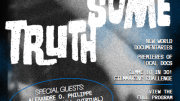Director Martin Scorsese and actor Leonardo DiCaprio pair up for the fourth time on Shutter Island, a film that looked thrilling in trailers but is not-so-thrilling in reality.
The film takes place in Boston in 1954, and follows U.S. Marshal Teddy Daniels (DiCaprio) and partner Chuck Aule (Mark Ruffalo) to Shutter Island, a mental institution for the criminally insane. There, the duo investigates the disappearance of a dangerous patient, Rachel Solando (Emily Mortimer), who apparently escaped from her cell in the middle of the night.
The staff at Shutter Island is not much help when questioned by Teddy, and find many of his questions humorous. To make matters worse, head psychiatrist Dr. Cawley (Ben Kingsley) is resistant to the investigation, no records of the staff could be given to Teddy and Rachel’s primary doctor has left for “vacation” (how convenient). This leaves Teddy and Chuck suspicious of everyone and thinking that Rachel probably had some help escaping.
Then things get even worse. Just as the investigation seems to be going nowhere, and Teddy and Chuck prepare to leave, a hurricane sweeps over the island trapping them there. The duo starts to uncover evidence that the hospital is brainwashing their patients and performing random surgeries on them. Teddy quickly comes to believe that he or Chuck will be the next ones that the hospital tries to get.
Shutter Island unfortunately has more than its share of flaws. For instance, throughout the film Teddy suffers migraines, which cause hallucinations of his dead wife and flashbacks to when he was a soldier in World War II. These sequences, which try to reveal important background information about Teddy, are often extremely jumpy, disorienting and hard to follow. Many also drag on quite a bit and could be cut.
The film’s music — always an important consideration in Scorsese films — often felt out of place. For instance, when Teddy and Chuck first enter the island, there is a string orchestra in the background playing one deep note simultaneously, mimicking a heartbeat. It was intense and sounded like it was building to something, but the scene was just the actors entering the island! I guess it could have been Scorsese letting the audience to know that this movie is going to be intense and scary, but, come on, it was a build up to the gates of a hospital! The hospital didn’t even look scary; it looked pretty normal.
There was also plenty of cringingly obvious green screen usage throughout. When Teddy and Chuck stand on a boat deck in an early scene, and again later when Teddy stands on a cliff, with phony sky and ocean in the background I could only think, “Wow, nice fake scenery. Does Scorsese even know how a green screen works?”
Finally, there was the issue of DiCaprio’s Boston accent, which he slipped in and out of haphazardly. In fairness, the rest of DiCaprio’s performance was probably about an eight out of 10. He really got into the character of Teddy and his emotions sold the performance, shaky accent notwithstanding.
Shutter Island was preceded by plenty of hype and, for a couple weeks, movie trailers were everywhere. But the best parts of the trailer — like when a patient attacks Teddy in a dark hallway — didn’t seem quite as jump-worthy in the actual film. When audiences go to see a thriller movie they expect that it will make them jump. Shutter Island doesn’t and it’s a disappointment.
The film does end on a high note, however, with an effective twist. Indeed, throughout the entire film, Scorsese wants the audience to follow Teddy’s journey and to be on his side, to believe what he believes, and to understand what he understands. When this is thrown into doubt at the film’s conclusion, it will be hard for the audience to believe, and should leave them with questions that linger even after the screen goes black.
Ultimately, I’d say people should see Shutter Island and make up their own mind about it. At the very least, the twist at the end will shock you, even if not much else does.
3 out of 5 stars




